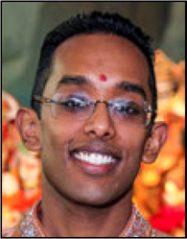Taking an active educational roll to help others decode and deepen their Hindu Identity
BY SHAWN BINDA

I AM HINDU, AND I AM ALSO Canadian, born and raised. My cultural background is Caribbean, with parents from Trinidad and Tobago. I have never been to India, nor do I speak any of its native languages. The core of how I choose to identify myself is that I am a Hindu first and foremost, as the foundation for all other parts of my character.
Identifying as a Hindu does not always come naturally to Hindus living in a place where our religion is not the dominant one. For me, coming to this point took time, self-reflection and a deep yearning to understand my religion.
For the past five years I have been involved in teaching Hinduism to teenagers and young adults every Sunday. I conduct classes at our mandir in Pickering, Ontario, for anyone interested. We cover related topics, have discussions and, most importantly, create an open environment for questions.
Until I started teaching the youth in my community about Hinduism, I didn’t realize that identifying as a Hindu does not come easily. Yes, I can certainly say, “I am proud to be Hindu”—which many young people my own age were apt to do when we were growing up—but I used to say that without understanding what it fully meant.
By teaching Hinduism, I came to understand our Sanatana Dharma in a deeper sense. While our pujas and rituals form a fundamental aspect of our religion, I came also to see the way Hinduism impacted my everyday life, from the minute I wake up to when my eyes close at night.
As I grew up, I realized that the teaching of Hinduism was lacking in my own community. Yes, we had a mandir where we would congregate for satsang, bhajans and discourses by our resident panditji, but the direct engagement of individuals was lacking. This current model of temple worship in North America is something I have encountered in my travels to many mandirs in Canada and the US.
While teaching Hinduism to the teenagers in my community, I would get many comments after class expressing the desire that the classes go longer so the students could ask more questions. I realized I had struck on something that resonated with this group: their desire to learn more in order to decode and deepen their Hindu identity. I realized that it was the direct engagement with all the youth in my classes that made Hinduism interesting. Through this interaction, Hinduism became something tangible, something real and something that could have an actual influence in their lives.
As attendance grew over the years, many younger students started to ask why I didn’t have an Instagram account or a website where my lessons could be posted. I told them there were already many different online resources dedicated to this. However, they continued to urge me in that direction and I finally decided to extend my own style of teaching to a broader audience. I started a YouTube channel to talk about Hinduism, explaining various philosophical concepts and, more importantly, trying to understand how one can incorporate Hinduism into a daily lifestyle. The channel launched in February of 2017, on Vasant Panchami.
I make no claims to be a pandit. I just want to show the youth of this generation that maintaining a Hindu identity is possible, provided we understand what it means to be Hindu and the reasons why we do the things we do. Hopefully these videos will inspire more people to think about what it means to be Hindu in the 21st century and beyond. Hinduism has many things to offer the world, and we must all do our part in ensuring it continues for years to come. See: bit.ly/hindu-lifestyle
SHAWN BINDA, 35, is the host of Hindu Lifestyle and is active in his community, teaching youth at the Durham Hindu Heritage Centre in Pickering, Ontario, Canada. Email: sb@shawnbinda.com